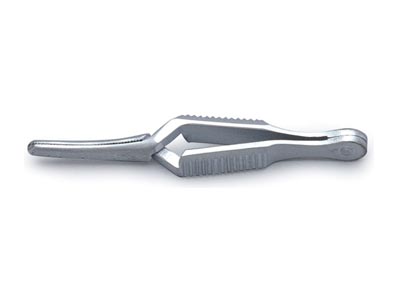Suture instruments are used to ligate, repair and approximate tissue after a surgical procedure.
- Needle holders : Needle holders, also known as needle forceps or needle drivers, are used in suturing during a surgical procedure. Needle holders typically have a textured tip for a secure hold. Often they have a ratchet (or other mechanism for locking). Some have tungsten carbide inserts in the tips. Tungsten carbide inserts are more durable than stainless steel, last longer and typically offer a better grip. Tungsten carbide (TC) is harder than stainless steel. Look for the gold handles which designate tungsten carbide inserts.
Titanium needle holders are lighter weight, which makes them easier to use during long procedures.
Choose your needle holders based on the size of the needle you are using, so that they securely hold your needle. The smaller the needle, the smaller the needle holder. - Skin staples : Staples are designed to be non-crushing when they are inserted into tissue. This section includes some of our most popular instruments used to aid in wound closure.
- Needle holder care : Replace your needle holders if you notice any of the following:
• Bent tip
• Hairline cracks in the jaws or the joint
• Cracks in the TC inserts
• Light shines through when you hold it in the closed position.
• Loose joint
• Ratchet mechanism fails to hold securely
• Rust cannot be removed
When testing your needle pullers, you should be able to securely hold a hair on your forearm. - Clips & Clamps : Save time in surgery using our reflex clips. They are a fast, effective suture alternative for wound closure. Choose the 9 mm clips for use in rats or 7 mm clips for mice and young rats. The spring-loaded clip applier is easy to use. You get minimal tissue trauma and maximum holding power. Use the clip remover to extract the clips when the wound heals. The clips, applier and remover are all autoclavable. Vessel clips are used to clamp arteries or veins during surgical procedures. These vascular clamps come in a variety of shapes and sizes.
- Needles : All surgical needles have a Spring Eye which allows the suture to be pressed into the eye instead of threaded. Taper point surgical needles pierce and spread tissue without cutting it. They are ideal for suturing delicate, soft tissue when minimal trauma is desired. Surgical needle measurements are taken across needle from eye to tip: Cutting edge surgical needles have sharp edges that penetrate easily through tough tissue. They are ideal for suturing skin and dense dermal tissue.
- Needle Holders, Titanium : These needle drivers are constructed of titanium, which offers several advantages for small animal surgical procedures: 100% anti-magnetic so it can be used for MRI applications Completely resistant to corrosion from nitric acid, chloride, saltwater, and industrial and organic chemicals Lightweight and strong with the tensile strength of carbon steel Titanium is more flexible and 40% lighter than Inox stainless steel When heated or cooled, the dimensions of titanium alloy change less than half of what stainless steel alloys will, making titanium surgical instruments much more durable even with autoclaving Titanium is stain-free and temperature resistant up to 430°C.
- Ring Handle Needle Holders : Standard needle holder are general purpose needle drivers.
- Skin Staplers : Surgical staples are commonly used in place of sutures for closing wounds after surgery. Staples are typically faster to apply than suturing by hand. Staple lines are accurate and consistent. And, wounds are not likely to leak. We offer reflex clips and surgical staples for quick wound closure.
- Spring Handle Needle Holders : Squeeze handle needle holders may be used ambidextrously. Micro needle holder are designed for use with small needles for delicate surgeries.
- Surgical Adhesives :The adhesive you choose will depend largely on your application. Use the guide below to select the appropriate glue for your life science research application.
• Cyanoacrylate Glues
• Epoxy Adhesives
• Hot Melt Glues
• Silicone Adhesives

